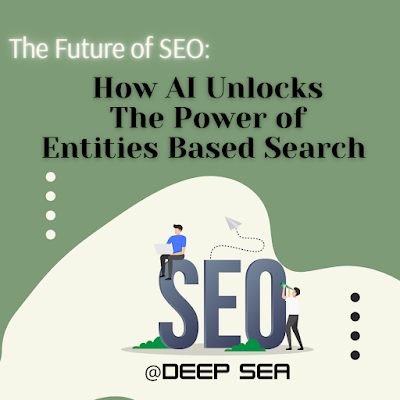The Future of SEO: How AI Unlocks the Power of Entities for Smarter Search
The Future Of SEO : AI Roll in The Entity Based SEO
"In 2023, Google processed over 8.5 billion searches daily—but less than half relied on simple keywords. Instead, users asked questions like, ‘Where’s the best vegan pizza near me?’ or ‘How does blockchain work?’ To answer these, search engines turned to AI-driven entity-based SEO. Here’s how it works—and why your SEO strategy needs it."
 |
| The Future Of SEO : AI Roll in The Entity Based SEO |
AI plays a transformative role in entity-based SEO by automating complex tasks, enhancing semantic understanding, and enabling smarter content strategies. Here’s how AI powers this field:
1. Entity Identification & Relationship Mapping
- Natural Language Processing (NLP):AI models like BERT (Google) or GPT-4 analyze text to identify entities and their contextual relationships. For example, NLP can detect that "Tesla" refers to the company, not Nikola Tesla, based on surrounding terms like "EV" or "Elon Musk."
- Tools: Google’s Natural Language API, IBM Watson, spaCy.
- Knowledge Graph Enrichment:AI maps how entities connect (e.g., "Apple → iPhone → iOS") to build semantic networks, helping search engines understand content depth and relevance.
2. Content Optimization & Semantic Analysis
- Semantic Keyword Expansion: AI tools like MarketMuse or Frase analyze top-ranking content to suggest related entities, synonyms, and subtopics (e.g., "plant-based diet" → "vegan recipes," "nutrient density").
- Content Gap Analysis: AI identifies missing entities or gaps in your content compared to competitors, ensuring comprehensive coverage of a topic.
3. User Intent Classification
- Query Understanding: AI classifies search queries into categories (informational, navigational, transactional) and identifies the entities involved. For example, the query "how to fix a leaky faucet" triggers entities like "plumbing tools," "DIY repair," and "water damage prevention."
- Intent Prediction: Tools like BrightEdge or SEMrush use AI to predict user intent and recommend content structures (e.g., FAQs, step-by-step guides).
4. Personalized Content Recommendations
- Behavioral Analysis: AI tracks user interactions (e.g., clicks, dwell time) to recommend related entities or content. For example, if a user reads about "keto diets," AI suggests content about "macros," "intermittent fasting," or "keto recipes."
- Dynamic Content Generation:Tools like Jasper.ai or Copy.ai use AI to generate entity-rich content drafts, product descriptions, or meta tags aligned with SEO goals.
5. Voice Search & Conversational SEO
- Natural Language Understanding (NLU): AI models like Google’s MUM interpret long-tail, conversational queries (e.g., "Where can I buy organic coffee beans near me?") by mapping entities like "organic coffee," "local stores," and "reviews."
- Voice Search Optimization: Tools like AnswerThePublic or SpeechText.ai use AI to analyze voice search patterns and optimize content for question-based queries.
6. Structured Data Automation
- Schema Markup Generation: AI tools like Schema App automatically generate structured data markup for entities (e.g., products, events) by scanning content, improving crawl efficiency.
- Entity Recognition in Images/Videos: AI-powered visual search (e.g., Google Lens) identifies entities in multimedia content, enabling SEO for non-text assets.
7. Predictive Analytics & Trend Forecasting
- Entity Trend Prediction: AI tools like TrendsGPT or Crayon predict rising entities (e.g., emerging tech terms or seasonal topics) to help brands create timely, relevant content.
- Ranking Factor Analysis: Platforms like BrightEdge or Aira use machine learning to correlate entity usage with ranking improvements, guiding SEO strategies.
8. Local SEO & Hyperlocal Entities
- Local Entity Recognition: AI identifies location-specific entities (e.g., "Brooklyn coffee shops," "Austin vegan restaurants") and optimizes content for local intent.
- Review Sentiment Analysis: Tools like Repustate or Brandwatch use AI to analyze reviews and identify entities linked to positive/negative sentiment (e.g., "service speed," "product quality").
9. Enhancing E-A-T (Expertise, Authority, Trust)
- Content Quality Scoring: AI evaluates content against E-A-T criteria by checking entity diversity, citation accuracy, and depth. Tools like Clearscope provide entity-driven content grades.
- Citation & Source Validation: AI verifies sources (e.g., linking "Harvard University" to its official site) to build topical authority.
Challenges & Considerations
- Data Privacy: AI tools must comply with regulations (e.g., GDPR) when processing user data.
- Over-Automation Risk: Human oversight is critical to avoid contextually irrelevant AI-generated content.
- Cost & Complexity: Advanced AI tools may require technical expertise or significant investment.
Real-World Examples
- The New York Times: Uses AI to analyze entity relationships in articles, improving internal linking and content depth.
- Amazon: Leverages AI to map product entities (e.g., "wireless headphones" → "Bluetooth 5.0," "battery life") for better search relevance.
- Spotify: Employs NLP to curate playlists based on entity-rich user queries (e.g., "upbeat workout songs").
Future of AI in Entity-Based SEO
- Zero-Click Search Optimization: AI will focus on answering queries directly (via featured snippets) by prioritizing entity-rich content.
- Multimodal SEO: AI will unify text, image, and video entities for holistic optimization (e.g., Google’s MUM model).
- Self-Learning Algorithms: AI systems will autonomously update entity networks based on real-time search behavior.
Conclusion
AI supercharges entity-based SEO by automating entity discovery, optimizing semantic relevance, and personalizing user experiences. By integrating AI tools, brands can future-proof their strategies in a search landscape increasingly driven by context, not just keywords. However, balancing automation with human creativity remains key to avoiding robotic, disconnected content.
Post a Comment